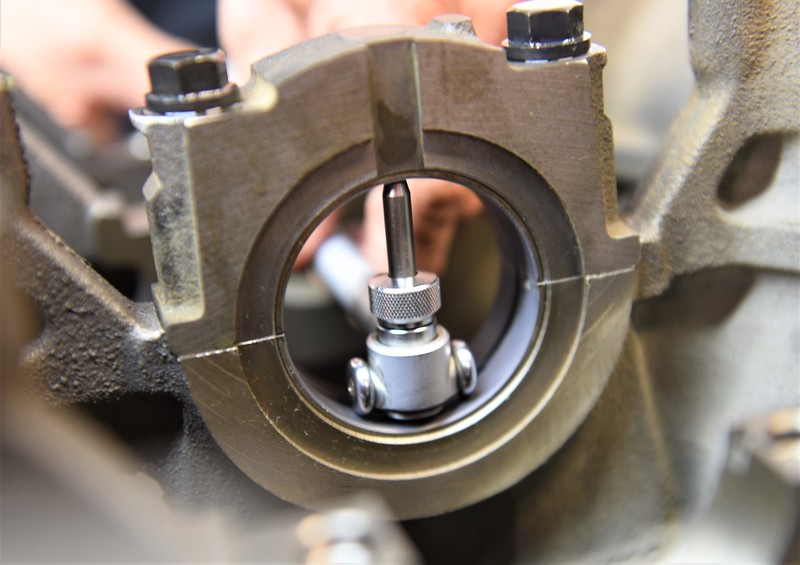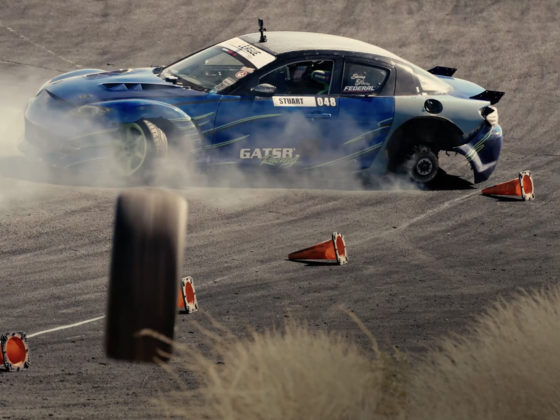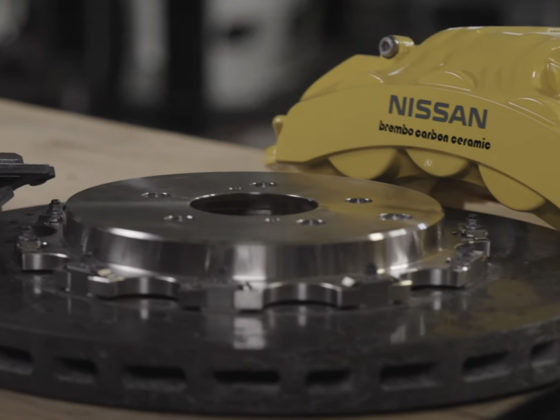
Most bore gauges come with a set of different size anvils for you to use depending on what size bore you are measuring. Pick the right one for your bearing bore and screw it on before you set your bore gauge to the journal diameter.

Now install your bearings in the main caps. We are using King XPC bearings here. Next, torque down your main caps to the proper torque. This is critical as you want to measure the bearings inside diameter once they are crushed. Now measure your bearing inside diameter as shown. You want to measure it here because sometimes the inner bore is tighter at the bearing parting line by design. If you zeroed the bore gauge using the journal diameter the number you come up with on your bore gauge is your main bearing clearance. For iron blocks, we like to run the clearances from the middle of the factory recommended range to the minimum side of the spec. For aluminum blocks, we like to run close to the factory minimum side of the spec due to expansion. To control the clearance we sometimes mix and match different thicknesses of select fit bearing shells. Sometimes we might have to align bore the block to get more crush to close up the clearances or grind the crank journals undersize and use an oversize bearing. What strategy to use depends on what sort of bearings we are using and what sizes are available. Everything depends on precise machining and we are very picky with who machines our motor parts.

Measure all your main bores and determine your clearances and decide if everything is ok or if you need to adjust using different sized bearing shells or with machining. Never just throw a motor together. Most people do this and that’s why many motors don’t last!

A little feel is needed when measuring using a bore gauge. Rock the gauge back and forth while watching the dial indicator. The middle of the reading is the correct diameter.

Now it’s time to measure your rod bearing bore diameter. We are installing King XPS bearings in a set of racing rods here.




18 comments
For a home hobbyist what are decent quality and reasonable costing micrometers and bore guages to feel comfortable enough verifying these measurements at home?
We use Mitutoyo. You have to use decent stuff because you are measuring very small differences.
Mike, what I don’t like about the bore gauges like the ones used in the picture ( All brands) is that they leave marks on the bearings. I think that some type of intrimik with the same leg set up as the bore gauges would be ideal for the job, however, such design does not exist. Hint Hint!!!!!!
it maybe burnishes the zinc flash on some bearings, big deal, on coated bearings it doesn’t do a thing.
I’ve always used Mitutoyo, and while the prices can be shocking, a trick I’ve found is checking around at pawn shops. With a little haggling and saying things like, “my work will need me to get this calibrated before I can use it.” Or if the tool is missing it’s case or reference block, you might be able to get the price down to $20 or so.
Very helpful article, but it definitely makes me feel like building (rebuilding) more modern engines at home / at the hobbyist level is pretty much going to become impossible. I’m just finishing up a KA24DE build, and I talked to a few “machine shops” who basically laughed in my face at the idea of a using a torque plate on “a small 4-cylinder motor,” so as you say, even finding a qualified machine shop can be a challenge, and that’s for a 30+ year-old engine.
Then there’s the tool cost which I’d think for most people is going to be a bore gauge, micrometer set, and rod bolt stretch gauge, which could easily be $1000 for Mitutoyo or something equivalent.
It feels like we’re about at the zenith of internal combustion engine technology in terms of power and efficiency, which is cool, but the understandable tradeoff (as you say) is that there are far fewer people / shops who can competently work at the level of 0.0001″ and smaller tolerances, so I do wonder what that will mean going forward.
You are really talking about the ultimate in power and reliability. FYI, I have taken apart and refurbished engines and replaced head gaskets for under a hundred dollars. You may want to look into domestic engines if you just want to enjoy the rebuild process without breaking the bank.
Have you tried to build an LS or Coyote engine, these are about domestic as you can get and they run very tight clearances. We see LS’s with very low oil pressure all the time, the result of someone just throwing some bearings in it, even other “pro” engine builders. We run at the tight end of the factory clearance or you get things like 10 psi hot idling oil pressure and 35 psi going full tilt, barely acceptable for a stockish engine but not a performance one. Maybe you can get a little less careful on an old SBC with an iron block but even then, measuring clearances is not breaking the bank. Most engine failures from people attempting to build engines are the result of #1 poor tuning #2 incorrect or sloppy clearances.
If bearing clearance is such a concern, the bores in the block for the main bearings should be checked for size and roundness first.
The main bores are always checked to see if they are out of round and out of plane to determine if the engine needs to be align bored.
Does bearing clearance also affect what oil viscosity to use after rebuild? Given the tight clearance that you like to follow, do you tend to recommend lower viscosity engine oil from factory recommended specs? Is it important to match the bearing clearance on all the journals?
Whenever we read factory rebuild manuals, we will always discover there are multiple bearing thickness to choose from during ordering. We could use bearing halves of different thickness to achieve the desired clearance required.
However when it comes to aftermarket bearings, I tend to notice one size fit all bearings even for popular engine types. How do you achieve your desired clearance with such bearings?
We never use a lower viscosity than the factory recommendation. We use King bearings because they come in small increment size differences so we can mix and match shells. Failing that, you can align bore the block and resize rods to the minimum size to close up clearances with crush or use an oversize bearing and machine the crank undersize precisely to the right diameter to get good clearances. It’s important to work with a good machine shop and have a good relationship with one.
What oil viscosity do you recommend your customers to use on the engines you built? Will it be too much work to machines those parts than to just use original bearings that comes in small size increments?
It really depends on the motor and end-use. OEM bearings are mostly not designed for racing use.
Do you somehow take into account how much the anvils on the gauge head dig into the bearing material? Not an issue on hard-faced race bearings, but it’s visible on soft stock bearings.
That’s why I always double-check with plastigauge. Even after measuring crank runout, journals, big end bores and main bores.
If you do things right, it won’t even make a mark.
Nice article, thank you.
I need some advice, I have Subaru STI 2008 2.5 L turbo engine and I know,
that theese blocks tends to flex a lot and also crankshaft need “a litlle more space- not to go metal on metal contact” so many people (engine builders) recommend me to go with bigger clearances on main journals.
But as I read this article recommendation is to go to tighter clearances on low minimum of factory standard specifications?
So how about Subaru EJ engines and bearing clearances?
Thank you,
BestRegards
Mike
I couldn’t help noticing you didn’t mention. rod side clearance. Is that not a concern, what are your thoughts on that? How would you correct too large of an end clearance? Thanks for taking the time to show how to properly take these measurements. Much appreciated.